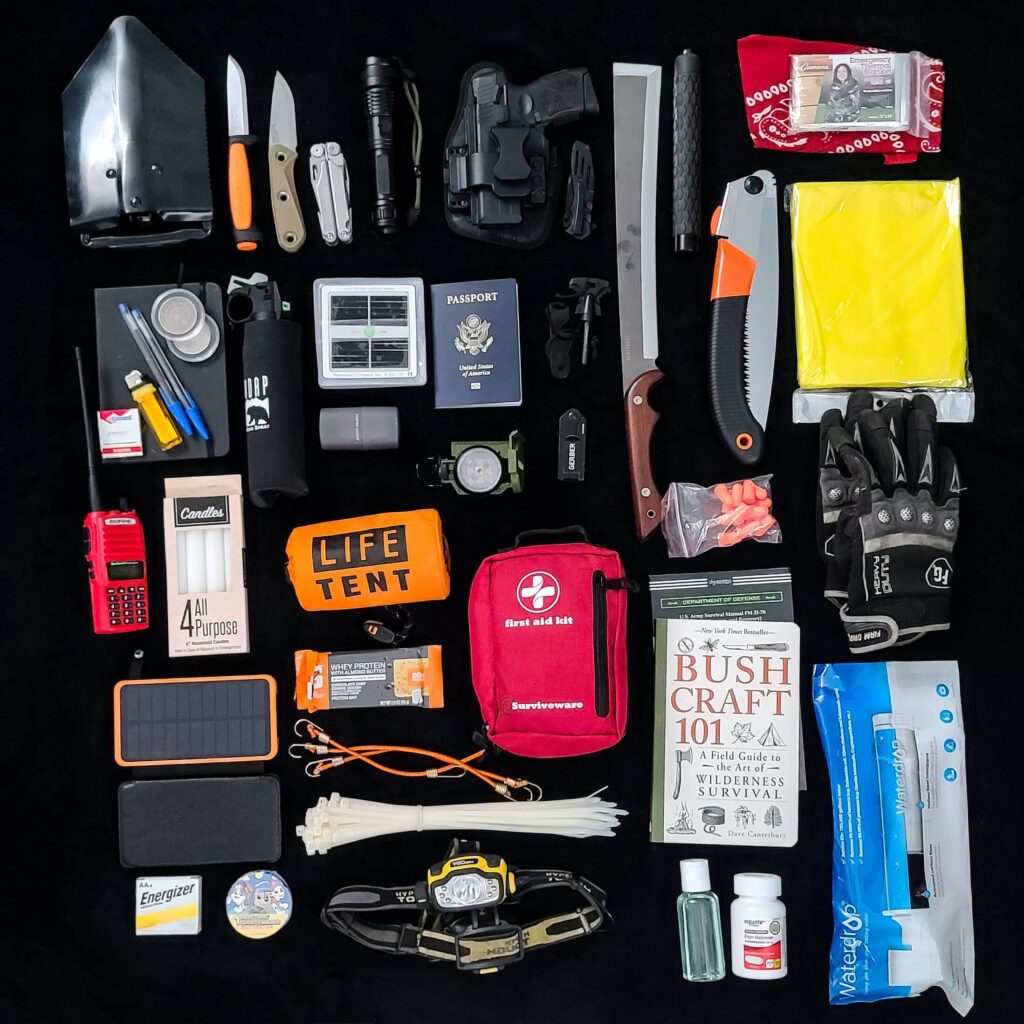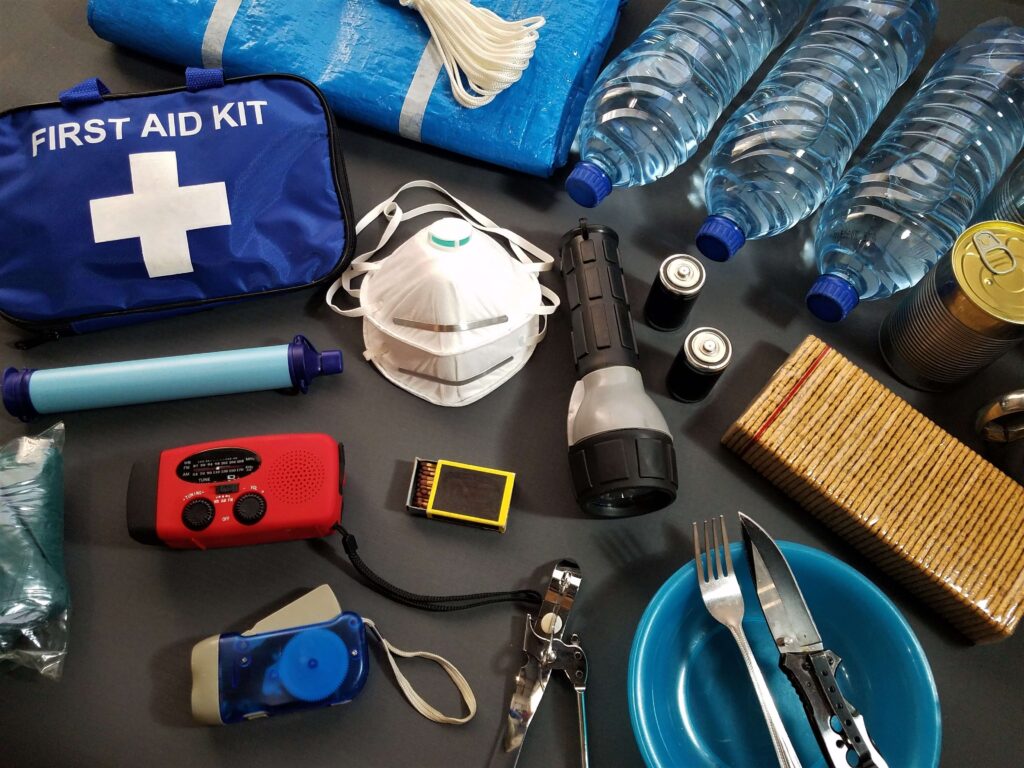In times of emergency, it’s crucial to have a well-prepared Bug Out Bag that can sustain you and your loved ones until help arrives. A Bug Out Bag is a survival kit containing essential items to help you navigate through unexpected situations, such as natural disasters, civil unrest, or even a sudden evacuation. You should carefully choose the contents of your bug-out bag based on your unique needs, the environment you’re in, and the duration of the emergency.
This article will highlight the top 10 essential items you should have in your Bug Out Bag. These items will help you survive and make your emergency situation more comfortable. From food and water to shelter and protection, we’ll cover everything you need to know to create a well-rounded Bug Out Bag that will give you peace of mind when the unexpected strikes.
- Water is the first and most critical item to have in your Bug Out Bag. Depending on the situation, you may not have access to clean drinking water for days or even weeks. Therefore, carrying enough water to sustain yourself and your family is essential. A good rule of thumb is to carry at least one gallon of water per person per day. You can either pack bottled water or invest in a high-quality water filtration system.
- Food. You may not have access to your regular food source in an emergency. Therefore, carrying non-perishable food items that can sustain you for several days is essential. These items can include energy bars, canned foods, and dried fruits. Pack food that is easy to carry and can provide the necessary nutrients your body needs.
- Shelter. In case of an emergency, you may have to leave your home or evacuate to a different location. Therefore, it’s crucial to have a shelter that can protect you from the elements. A sturdy tent or a lightweight tarp can provide shelter and protect you from rain, wind, and sun. Packaging a sleeping bag and warm clothing is essential to keep you comfortable during the night. Remember to pack items that are easy to carry and can withstand harsh weather conditions.
- A multi-purpose tool is an essential item that should be in every Bug Out Bag. A reliable multi-tool can be used for various purposes such as cutting, sawing, screwing, and hammering. It can also come in handy when repairing gear or building shelter. Make sure to choose a high-quality multi-tool that is durable and easy to use.
- A first aid kit is a must-have item in any Bug Out Bag. It should contain all the necessary medical supplies such as bandages, gauze, antiseptic, and pain relievers. Additionally, if you or anyone in your family has specific medical needs such as prescription medications or inhalers, make sure to include them in the first aid kit.
- A map and a compass are essential items that can help you navigate through unfamiliar territory. In an emergency, you may have to evacuate to a different location or find an alternate route to safety. A map and compass can help you navigate the terrain and reach your destination safely. You can also wear a GPS watch; however, you may face issues if there is a major catastrophe.
- A communication device such as a two-way radio or a cell phone can be a lifesaver in an emergency. It can help you stay in contact with your family or friends, call for help, or receive important updates. Pack spare batteries or a power bank to keep your communication device powered.
- A fire starter kit is essential to help you start a fire quickly and easily. A fire can provide warmth, light, and a means to cook food. A reliable fire starter kit should include waterproof matches, a lighter, and fire starter sticks.
- A hygiene kit containing items such as soap, toilet paper, and hand sanitizer is essential to maintain good hygiene and prevent the spread of diseases in an emergency. You can also include a toothbrush, toothpaste, and feminine hygiene products if necessary.
- Lastly, a self-defense tool such as pepper spray or a stun gun can protect in case of an attack. Learn how to use the tool effectively and legally in your area. It’s essential to prioritize safety and avoid confrontations whenever possible.

Key Considerations to Keep in Mind
Having a well-equipped Bug Out Bag is just the first step towards emergency preparedness. For it to be truly effective in an emergency, knowing how to use it properly is essential. Here are a few things to consider:
- Practice using your Bug Out Bag: It’s important to practice using it before you need it. This includes wearing the bag, testing the items inside, and getting comfortable with the weight and size of the bag. Practice setting up your shelter, using your water filtration system, and starting a fire with the tools in your bag. This way, you will be prepared and confident in your abilities in an emergency.
- Rotate perishable items: Items such as food, water, and medications have expiration dates, so it’s important to regularly check and rotate these items to ensure they are fresh and effective. This can be done every few months, depending on the expiration dates of the items.
- Consider the season and climate: The contents of your Bug Out Bag should be adjusted depending on the season and climate you are in. For example, you may need heavier clothing and warmer sleeping gear for winter, while a lightweight sleeping bag and clothing may be sufficient for summer.
- Stay informed and up-to-date: The contents of your Bug Out Bag should be regularly reviewed and updated to ensure you have the most up-to-date and relevant items. Stay informed about your area’s potential threats and risks, and adjust your Bug Out Bag accordingly.
- Don’t rely solely on your Bug Out Bag: While a Bug Out Bag is essential for emergency preparedness, it’s important to have multiple backup plans in case your bag is lost or stolen. Consider keeping a smaller emergency kit in your car or office, and have a backup plan for evacuation routes and meeting points with family or friends.
- Customize your Bug Out Bag: A Bug Out Bag should be tailored to your specific needs and circumstances. For example, if you have a medical condition, you may need to include specific medications or supplies. If you have a pet, you may also need to include food and supplies for them. Customize your bag to fit your individual needs.
- Consider the weight of your Bug Out Bag: While having all the necessary items in your Bug Out Bag is important, it’s also important to keep the weight manageable. A bag that is too heavy can slow you down and make it difficult to travel long distances. If possible, try to keep your bag under 20% of your body weight.
- Store your Bug Out Bag safely: Your Bug Out Bag should be stored in a safe and easily accessible location. Consider storing it where you can quickly grab it and go in an emergency, such as near an exit or in your car.
- Be prepared to adjust your Bug Out Bag: Your Bug Out Bag should be a living document regularly updated and adjusted as needed. As your circumstances change or new items become available, be prepared to adjust the contents of your bag to ensure you have the best possible chance of surviving an emergency.

How to Pack a Bug Out Bag
Packing a Bug Out Bag can be daunting, but it is essential for emergency preparedness. Here are some steps to help you pack a Bug Out Bag:
- Choose the right bag: The first step is to choose the right bag. Look for a durable, waterproof bag that is comfortable to wear and has enough space to fit all your essential items.
- Make a checklist: Make a checklist of all the items you need in your Bug Out Bag. This should include food, water, shelter, clothing, first aid supplies, tools, and other essential items.
- Organize your items: Organize your items into categories such as food, water, shelter, etc. This will make it easier to pack your bag and ensure you have everything you need.
- Pack your bag: Pack the heaviest and bulkiest items at the bottom. This will help distribute the weight evenly and make it easier to carry. Then, pack the lighter and smaller items on top.
- Consider weight and balance: Be mindful of the weight and balance of your bag. Try to distribute the weight evenly and avoid overpacking.
- Test your bag: Once you have packed it, test it out to ensure it is comfortable to wear and fits properly. You may need to adjust the straps or remove items to improve the fit.
- Review and update regularly: It is important to review and update your Bug Out Bag regularly. Check expiration dates on food and medications, replace items that have been used, and make any necessary adjustments based on changes in your circumstances.
By following these steps, you can pack a Bug Out Bag tailored to your individual needs and help you stay prepared in an emergency.
How to Choose the Right Bug Out Bag
Choosing the right bag for your Bug Out Bag is essential for ensuring you have a comfortable and practical pack. Here are some tips for choosing the right bag:
- Durability: Look for a bag made of durable materials that can withstand rough use and harsh conditions.
- Comfort: A comfortable bag is essential for long-term use. Look for a bag with padded shoulder straps, a padded back panel, and a waist belt to help distribute weight and prevent back strain.
- Size: Choose a bag that is appropriate for your needs. A bag that is too small may not be able to fit all of your essential items, while a bag that is too large may be too heavy to carry.
- Organization: Look for a bag with multiple compartments and pockets to help you organize your items.
- Accessibility: Choose a bag that allows you to access your items, especially in emergencies, easily.

Once You Have Chosen the Right Bug Out Bag, it is Important to Stay Prepared. Here are Some Tips to Stay Prepared:
- Review and update your Bug Out Bag regularly: Check your bag regularly to ensure that all items are in good condition and not expired.
- Practice using your Bug Out Bag: Practice packing and using your Bug Out Bag so that you are familiar with its contents and how to use them in an emergency.
- Stay informed: Stay up-to-date on weather and emergency alerts to be prepared for any potential situations.
- Create a plan: Create an emergency plan with your family or friends, so everyone knows what to do.
- Learn basic survival skills: Basic survival skills are important such as starting a fire, finding water, and building a shelter to be prepared for any situation.
By choosing the right bag and staying prepared, you can be confident that you are ready for any emergency.
What is the Difference Between a Bug Out Bag and a 72-Hour Kit?
A Bug Out Bag and a 72-hour kit is survival kits, but they serve slightly different purposes.
A Bug Out Bag is designed to help you evacuate quickly in case of an emergency, such as a natural disaster, civil unrest, or sudden evacuation. It usually contains essential items that can help you survive for an extended period, such as food, water, shelter, and tools. A Bug Out Bag aims to help you get out of harm’s way and reach a safe location.
On the other hand, a 72-hour kit is designed to help you survive for up to 72 hours in case of an emergency, such as a power outage, severe weather, or other short-term events. It usually contains essential items such as food, water, shelter, and first aid supplies, but it may not include as many long-term survival items as a Bug Out Bag. The goal of a 72-hour kit is to help you sustain yourself and your family until help arrives or the situation resolves.
A Bug Out Bag is designed for longer-term survival and evacuation, while a 72-hour kit is intended for short-term survival in a localized emergency.
Should You Carry Cash in Your Bug Out Bag?
Yes, carrying cash in your Bug Out Bag is a good idea. ATMs may be down or inaccessible in an emergency, and credit/debit cards may not work due to power outages or communication failures. In such situations, having cash on hand can be very useful.
It’s recommended to carry a mix of small and large bills and some coins to be prepared for various situations. Additionally, it’s important to keep the cash in a waterproof and secure container to protect it from the elements and potential theft.
It’s also a good idea to keep cash in your Bug Out Bag to purchase supplies, transportation, or other necessities during evacuation. Make sure to periodically check and update the amount of cash in your Bug Out Bag to ensure it’s sufficient for your needs.
Should You Buy a Pre-Made Bug Out Bag Or Make Your Own?
Whether to buy a pre-made Bug Out Bag or make your own is a personal decision that depends on several factors.
Buying a pre-made Bug Out Bag can be convenient and save you time, as the bag is assembled and ready to go. These bags are usually designed by survival experts and contain all the essential items needed for an emergency. Additionally, pre-made bags may be cheaper than buying each item separately.
However, pre-made bags may not be customized to your specific needs, and you may end up with items you don’t need or miss out on items critical to your situation. Additionally, the quality of the items in pre-made bags may vary, and some items may not be of the quality or durability you need for a prolonged emergency situation.
On the other hand, making your own Bug Out Bag allows you to tailor it to your needs and preferences. You can choose the most important items to you and ensure they are of the quality and durability you require. Making your bag can also be more cost-effective in the long run, as you can purchase items on sale or use things you already own.
In summary, buying a pre-made Bug Out Bag and making your own have pros and cons. Ultimately, the best choice depends on your budget, time, and specific needs. If you decide to make your bag, do your research and include all the essential items you may need for your unique situation.
How Much You Spend on a Bug Out Bag
The cost of a Bug Out Bag can vary greatly depending on the quality and quantity of items included. While investing in quality items that will last and perform well in emergencies is essential, the overall cost of your Bug Out Bag should be within your budget.
There is no fixed price for a Bug Out Bag, as the cost depends on several factors, including the type of bag, the quality of the items, and the number of items included. Some pre-made bags can cost as little as $50, while others can cost several hundred dollars. Similarly, making your bag can cost anywhere from a few hundred to several thousand dollars, depending on the items you choose to include.
It’s important to prioritize the essential things in your Bug Out Bag and allocate your budget accordingly. For example, investing in a good quality backpack and a durable shelter may be worth the extra cost, while other items such as food and water can be purchased at a lower price.
In summary, the cost of a Bug Out Bag can vary widely, and there is no one-size-fits-all answer to how much you should spend. It’s important to prioritize the essential items and invest in quality items that will last and perform well in emergencies while staying within your budget.
How Large Should My Bug Out Bag Be?
The size of your Bug Out Bag depends on several factors, including your personal needs, the duration of your evacuation, and the situation you may encounter. The general rule of thumb is to choose a bag large enough to hold all the essential items you need but not so large that it becomes cumbersome and difficult to carry.
A good starting point for a Bug Out Bag is a backpack between 30 and 50 liters in capacity. This bag is usually large enough to hold all the essential items for a 72-hour emergency, including food, water, shelter, clothing, and first aid supplies. However, you may need a larger bag if you have specific needs or anticipate a longer evacuation time.
Choosing a bag that fits comfortably and securely on your back is essential, as you may carry it for extended periods. Ensure the bag is adjustable and has padded back and shoulder straps to distribute the weight evenly and reduce discomfort.
Ultimately, the size of your Bug Out Bag will depend on your individual needs and situation. It’s essential to carefully consider the items you need to include and choose a bag that can comfortably hold everything while remaining manageable to carry.
Conclusion
A well-prepared Bug Out Bag can make all the difference in an emergency. Packaging the right items that can help you survive and stay comfortable until help arrives is crucial. Remember to customize your Bug Out Bag based on your unique needs, your environment, and the emergency duration. Following these tips, you can create a Bug Out Bag that will give you peace of mind and ensure your safety in an emergency.
Frequently Asked Questions About Bug Out Bags:
What is a Bug Out Bag?
A Bug Out Bag is a survival kit containing essential items to help you navigate unexpected situations, such as natural disasters, civil unrest, or sudden evacuation.
What should be included in a Bug Out Bag?
A well-prepared Bug Out Bag should include water, food, shelter, multi-purpose tools, a first aid kit, a map and compass, a communication device, a fire starter kit, a hygiene kit, and a self-defense tool.
How much water should be packed in a Bug Out Bag?
A good rule of thumb is to pack at least one gallon of water per person per day. However, the amount of water you pack may vary based on your unique needs, your environment, and the emergency’s duration.
Should I pack perishable foods in my Bug Out Bag?
No, it’s best to pack non-perishable food items that can sustain you for several days. These items can include energy bars, canned foods, and dried fruits.
Can I pack prescription medications in my Bug Out Bag?
If you or anyone in your family has specific medical needs, such as prescription medications or inhalers, include them in the first aid kit.
Can I use my cell phone as a communication device in my Bug Out Bag?
A cell phone can be a valuable communication device in an emergency. However, pack spare batteries or a power bank to power your communication device.
Is carrying a self-defense tool in my Bug Out Bag legal?
The legality of carrying a self-defense tool such as pepper spray or a stun gun may vary based on your state or country. Learn how to use the tool effectively and legally in your area.

Jerome is an avid outdoorsman who moonlights as an attorney when he’s not creating the world’s greatest online content.
Related posts:
- The Ultimate Survival Kit for the Modern Day Warrior […]...
- The Ultimate Battery-Powered Water Purifier For Emergency and Disasters […]...
- The Ultimate Guide to Choosing the Perfect Gun Safe for Your Home […]...
- Ultimate Guide to Buying Tactical Sunglasses […]...
- The Ultimate Guide to Cleaning Guns […]...
- Surviving the Wild: A Guide to Thrilling Hiking Adventures in Bear Country […]...
- Uncharted Supply Co.’s THE ZEUS: The Ultimate Portable Jump Starter and USB Charger […]...
- Advantages of Having a Prepackaged Emergency Food Supply […]...
- Exploring the Desert: A Guide to Practical Considerations for Safe Desert Exploration […]...
- Which CB Radio is Right For Your Truck? The Definitive Guide […]...
- Ready Hour Black Bean Burger Mix – The Perfect Addition to Your Emergency Food Supply […]...
- Securing Your Food with Bear-Proof Containers While Camping […]...


